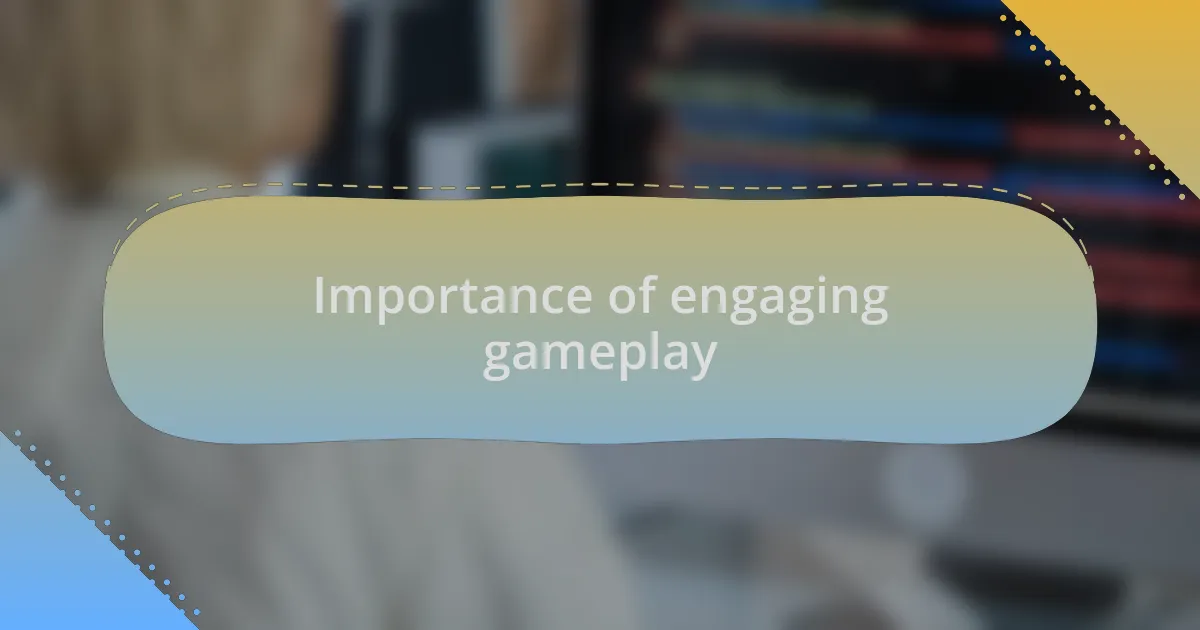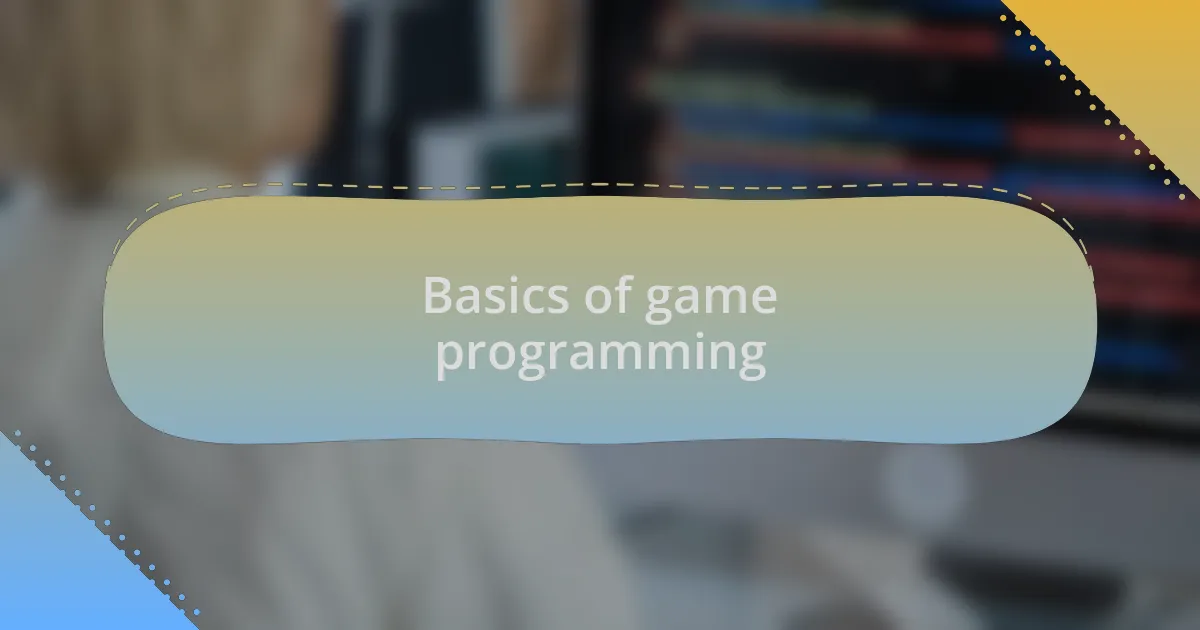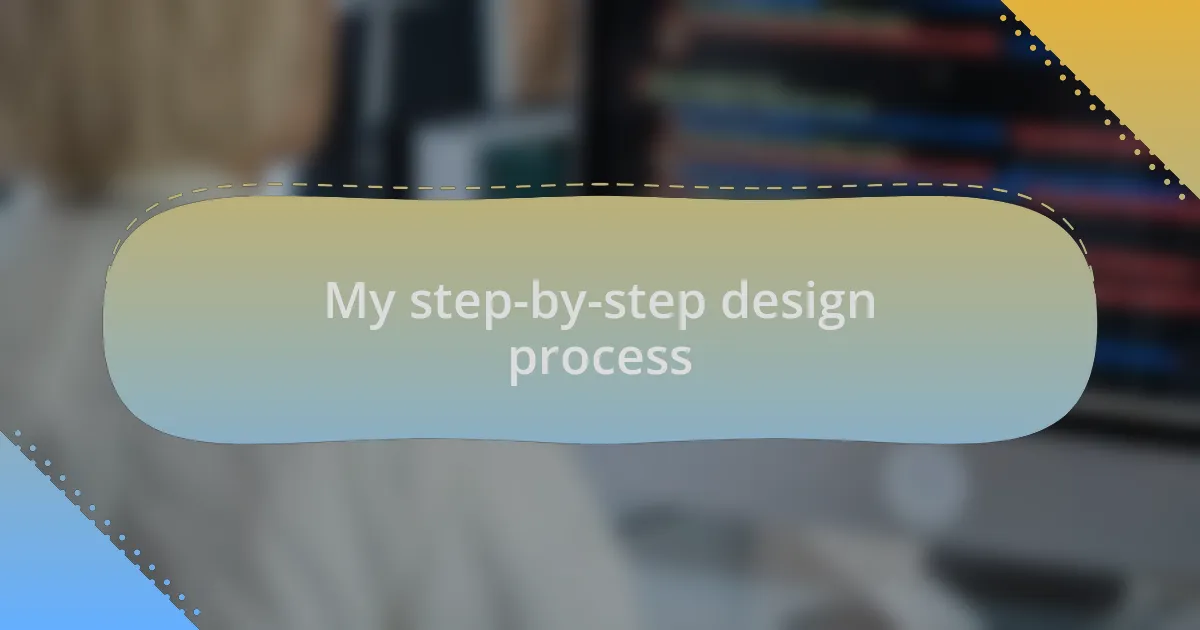Key takeaways:
- Gameplay experiences rely on emotional connections, varying player motivations, and a balance of challenge and reward to create memorable journeys.
- Engaging gameplay enhances player retention through dynamic difficulty adjustments, captivating narratives, and social interactions among players.
- Basic programming knowledge and fundamentals, such as game loops and mechanics, are crucial for creating responsive and immersive gameplay.
- Designing with player feedback in mind, incorporating intuitive controls, and offering personalization options significantly improve user experience.

Understanding gameplay experiences
Gameplay experience encompasses so much more than just mechanics and graphics; it’s about how players feel while engaging with a game. I remember the first time I played a narrative-driven title that made me genuinely cry over a character’s fate. That emotional connection is what transforms gameplay from just moving pixels on a screen to a memorable journey.
Have you ever found yourself immersed in a game world, feeling the thrill of a challenging level while your heart races? That feeling is the result of an intricate balance between difficulty and reward, a key component of impactful gameplay. I strive to create moments where players feel both challenged and victorious, allowing them to revel in their achievements.
Moreover, understanding different player motivations is crucial. Some players seek competition, while others crave exploration or storytelling. I once hosted a playtest focusing on diverse player types; it was enlightening to see how each group approached the same game differently. This diversity shapes my design decisions, ensuring that every gameplay experience can resonate, no matter the player’s style.

Importance of engaging gameplay
Engaging gameplay is essential because it keeps players returning for more. I recall a game I developed where I implemented a dynamic difficulty adjustment. I was amazed by how players reacted when they felt both challenged and empowered to overcome obstacles. This balance not only hooked them but also intensified their emotional investment in the storyline and characters, proving that engagement can significantly enhance retention.
Think about it: when was the last time a game truly captivated you? For me, it was a simple puzzle game that incorporated storytelling elements. As I pieced together the narrative, each solved puzzle brought a rewarding sense of accomplishment that made me eager to uncover what happened next. This is a perfect example of how engaging gameplay ignites curiosity and drives players deeper into the experience, resulting in memorable moments that stick with them long after the game is over.
The social aspect of gameplay also plays a significant role in engagement. I’ve seen firsthand how cooperative multiplayer elements can turn an ordinary game night into a bonding experience among friends. When players collaborate or compete, they create shared memories filled with laughter, excitement, and even frustration. This connection not only amplifies engagement but builds a community around the game, which is vital for its long-term success.

Basics of game programming
When starting out in game programming, understanding the fundamental concepts is crucial. It’s like laying the groundwork for a house; if the foundation is unstable, everything built on it will falter. For me, grasping the basics of programming languages like C++ or Python was a game changer. I vividly remember the feeling of finally creating a simple character that could move across the screen. Seeing that character come to life was incredibly rewarding and showed me the power of coding.
Game loops are another foundational concept that I found fascinating. Essentially, a game loop is where your game continuously checks for player input, updates the game state, and draws everything on the screen. This process is what makes games responsive and dynamic. I often reflect on my early projects where I implemented this loop for the first time; the thrill of seeing my character jump and interact with the environment made all the late-night coding sessions worthwhile.
Don’t underestimate the significance of basic game mechanics either. Mechanics like scoring, health systems, and level progression are what give players a sense of achievement. I recall developing a health bar for my first game—when I tested it and saw the bar visually drop with every hit taken, it felt like I had unlocked a new level of understanding in game design. How do you want players to feel in your game? This question often drives my design decisions and helps create an immersive player experience right from the start.

Key elements of appealing gameplay
One of the key elements of appealing gameplay is engaging mechanics that effectively balance challenge and reward. I remember designing a puzzle game where players had to solve increasingly complex riddles to advance. The joy I felt when I watched players experience that “aha!” moment was remarkable; it reminded me how important it is to provide just the right level of challenge. Striking the right balance keeps players involved and eager to continue.
Another essential aspect is a captivating narrative. I once worked on a game where the story unfolded through character interactions. Crafting dialogue that revealed the protagonist’s background made players emotionally invested. It’s fascinating to see how a compelling narrative can draw players deeper into the game world, transforming mere gameplay into a moving experience. Have you ever found yourself so wrapped up in a story that you lost track of time? That’s the magic of a strong narrative.
Finally, an inviting art style can enhance gameplay significantly. When I first experimented with vibrant visuals in my games, the feedback was overwhelmingly positive. I noticed players were more drawn to the game simply because of its aesthetic appeal. It’s incredible how colors, styles, and animations can set the tone and create a unique atmosphere that resonates with players on an emotional level. What visual elements do you think are most impactful in creating an appealing game?

Techniques for enhancing user experience
To enhance user experience, one technique that has proven effective for me is implementing intuitive controls. I recall a particular game prototype I developed, where I focused extensively on the control layout. After several iterations and player testing, I realized that simplicity can be a game-changer. Have you ever played a game and struggled with the controls? It can be frustrating and lead to a negative experience. By ensuring that controls feel natural and responsive, I was able to see players diving right into the action without hesitation.
Another approach I’ve utilized is providing meaningful feedback during gameplay. I had a breakthrough moment while creating a platformer that incorporated visual and auditory cues for every successful action—like completing a level or defeating an enemy. The players responded enthusiastically to these instant accolades, which validated their efforts. It got me thinking: how much more engaging can a game become when players receive constant validation? Taking the time to develop these feedback mechanisms not only enhances immersion but keeps players motivated throughout their journey.
Additionally, personalizing the gameplay experience can really resonate with players. In a recent project, I introduced character customization options that allowed players to express themselves. The joy I witnessed when players changed their avatars to reflect their personality was heartwarming. It made me question how much a player’s unique touch can enhance their connection to the game. Being able to see a piece of themselves in the game world often leads to a richer and more memorable experience.

Personal insights on gameplay design
When I think about gameplay design, one key insight that stands out is the importance of pacing. I once worked on a time-sensitive puzzle game where I intentionally varied the challenge levels across different stages. Players would often tell me how they appreciated moments of tension followed by brief relaxation—much like a rollercoaster ride. Isn’t it fascinating how the rhythm of a game can create emotional highs and lows, making the journey all the more thrilling?
Another aspect I’ve come to value is the role of storytelling in gameplay. During a recent project, I integrated a narrative that unfolded based on player choices. I witnessed firsthand how players became more invested in their decisions, often discussing the storylines with friends outside the game. This made me realize: how deeply can a rich narrative resonate with players? The impact was undeniable; a compelling story transforms a simple game into an unforgettable experience.
Collaboration among players is another critical design element I find invaluable. I remember developing a co-op multiplayer game where teamwork was essential. Players often shared their excitement about strategizing together, which led to a palpable sense of camaraderie. Have you ever felt that rush when your friends and you successfully conquered an in-game challenge? This shared experience not only strengthens friendships but also enriches the overall gameplay, making it a memorable adventure for everyone involved.

My step-by-step design process
When I embark on a new game design project, my very first step is defining the core experience I want to deliver. Recently, while conceptualizing a platformer, I focused on the feeling of discovery. I sketched out environments that encouraged exploration, which led me to ask: what if each level introduced a new mechanic that surprised players? This initial brainstorming phase sets the tone for everything that follows.
Next, I dive into prototyping, often using simple tools like paper or digital mock-ups. I once created a prototype for a tower defense game using LEGO blocks on my kitchen table. It might sound quirky, but physically building the levels helped me visualize gameplay dynamics in a tactile way. Wouldn’t it be great if we could all engage with our designs like that? By experimenting with a hands-on approach, I can quickly spot potential issues and iterate without the pressure of formal coding.
Once the basic gameplay mechanics are solidified, I turn my attention to player feedback. I remember hosting a small playtest with friends for a rhythm game I was developing. Their laughter and reactions to unexpected challenges sparked enlightening conversations about difficulty and engagement. Isn’t it incredible how others can offer perspectives we might overlook? Gathering insights from real players is invaluable; it ensures that the experience resonates and feels enjoyable.